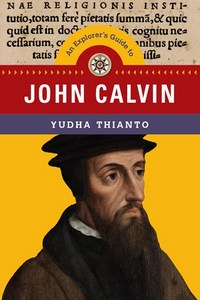 An Explorer’s Guide to John Calvin
An Explorer’s Guide to John Calvin
DETAILS: Series: Explorer's Guides Series Publisher: IVP Academic Publication Date: July 11, 2022 Format: eARC Length: 256 pg. Read Date: June 12-19, 2022

What’s An Explorer’s Guide to John Calvin About?
IVP Academic’s website describes the Explorer’s Guide Series as:
Anyone who has ventured into new territory knows the importance and benefit of having an experienced guide. Discovering the classics of Christian theology is no different.
The Explorer’s Guide Series acts as a guide for those who are exploring some of the great Christian texts and theologians from the church’s history.
Written by scholars with years of expertise, these volumes will acquaint readers with the sometimes unfamiliar context in which these classic texts were written and help readers navigate the rich yet often complex terrain of Christian theology. New and experienced readers alike will benefit from these volumes as they continue on their journey of faith.
This volume focuses on John Calvin, the Genevan Reformer. Yudha Thianto has been introducing students at Trinity Christian College to Calvin for years. Now he aims to bring an accessible overview of his life and thought through this book.
Part One: Calvin the Man
The first part of this book focuses on the historical context and the person of Calvin. Why do people still read him today? Why is he so important—or at least why is he regarded as such?
After sketching out why Calvin’s worthy of study, Thianto gives a brief (34 page) biography of Calvin. I’ve read a handful of full-length biographies of John Calvin, and I learned a thing or two from this.
Thianto follows this biography with a FAQ about Calvin—addressing several important questions and controversies about him and his teaching. Several parts of that FAQ were impressive, and I appreciated his approach to it (he did duck a couple of typical controversial points that are brought up—but it’s safe to argue that those are for less introductory works). Then he spends a chapter focusing on Calvin as a pastor. It covers some of the material from the biography, but from a different angle—and it covers a lot of additional material, too. Whatever Calvin’s legacy may be, this chapter addresses what was likely the most important part of his life to him.
Part Two: A Guide to The Institutes of the Christian Religion
A little more than half of the book is spent on the book Calvin’s best known for. Thianto spends a chapter talking about the different editions the book went through, where Calvin was in his career when each was written, and discusses some of the major differences between editions.
The final version was the 1559 edition, which is composed of four books/parts. Thianto spends one chapter on each book—describing the flow of thought, some important arguments made, and the major doctrinal teachings.
This is not an easy work to summarize and condense into a little over 100 pages, and I’m sure some will say Thianto glossed over or skipped something important—he undoubtedly did. But he also covered most (if not all) of the essentials). Something like this part of the book would be great to have for someone diving into the book for the first time.
So, what did I think about An Explorer’s Guide to John Calvin?
First, I really like the idea for this series, and hope to get my hands on other volumes. Naturally, I think someone as ill-understood and intimidating as Calvin is a good subject for this kind of book.
I appreciated Thianto’s approach to Calvin, the misunderstandings surrounding him (although he doesn’t cover all of them), and his writings. His experiences in the classroom have given him a solid understanding of those things that need to be covered for someone’s initial/early exposure to the Reformer, and it shows.
As this is supposed to be a guide for those with little-to-no exposure to Calvin, I can’t complain about the lack of depth displayed on some issues—and I really wouldn’t want to, anyway. The only thing that jumped out at me to make me wonder about the book is a point in the conclusion where he suggested that different beliefs about the Trinity are equivalent to differences regarding sacraments or predestination and that Calvin would see them as such. It was a minor point in the conclusion, and I think the overall point was sound—but the Trinity isn’t something Calvin would put on the same level as a debatable point of doctrine.
This is a great resource—a fantastic introduction to Calvin and a handy guide to reading the Institutes for yourself. If you’re curious about Calvin and don’t want to do the heavy lifting required by a full biography and/or reading his Institutes, I’d strongly recommend picking this up and giving it a read (and hanging on to it for future reference).
Disclaimer: I received this eARC from InterVarsity Press via NetGalley in exchange for this post—thanks to both for this.

This post contains an affiliate link. If you purchase from it, I will get a small commission at no additional cost to you. As always, opinions are my own.
![]()




Read Irresponsibly, but please Comment Responsibly